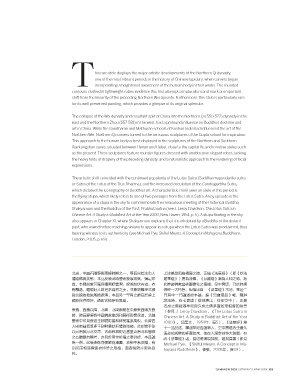Page 121 - Sotheby's Junkunc Collection March 2019
P. 121
his rare stele displays the major artistic developments of the Northern Qi dynasty,
one of the most vibrant periods in the history of Chinese lapidary, when carvers began
Tincorporating a heightened awareness of the human body in their works. The rounded
contours clothed in lightweight robes evidence this first attempt at naturalism and mark an important
shift from the linearity of the preceding Northern Wei dynasty. Furthermore, this stele is particularly rare
for its well-preserved painting, which provides a glimpse of its original splendor.
The collapse of the Wei dynasty and resultant split of China into the Northern Qi (550-577) dynasty in the
east and the Northern Zhou (557-581) in the west, had a profound influence on Buddhist doctrine and
art in China. While the Gandharan and Mathuran schools of Kushan India had influenced the art of the
Northern Wei, Northern Qi carvers turned to the sensuous sculptures of the Gupta school for inspiration.
This approach to the human body is best displayed in the sculptures of the Northern and Southern
Xiantangshan caves, situated between Henan and Hebei, close to the capital Ye, and in votive steles such
as the present. These sculptures feature rounder figures dressed with unobtrusive elegant robes, lacking
the heavy folds of drapery of the preceding dynasty, and a naturalistic approach to the rendering of facial
expressions.
The artistic shift coincided with the continued popularity of the Lotus Sutra (Saddharmapundarika sutra
or Sutra of the Lotus of the True Dharma), and the increased circulation of the Candragarbha Sutra,
which dictated the iconography of Buddhist art. A characteristic motif seen on stele of this period is
the flying stupa, which likely refers to one of two passages from the Lotus Sutra. A key episode is the
appearance of a stupa in the sky to commemorate the miraculous meeting of the Historical Buddha,
Shakyamuni and the Buddha of the Past, Prabhutaratna (see J. Leroy Davidson, The Lotus Sutra in
Chinese Art. A Study in Buddhist Art of the Year 1000, New Haven, 1954, p. 5). A stupa floating in the sky
also appears in Chapter XI, where Shakyamuni explains that it is inhabited by a Buddha of the distant
past, who vowed before reaching nirvana to appear in a stupa when the Lotus Sutra was proclaimed, thus
bearing witness to its authenticity (see Michael Pye, Skilful Means. A Concept in Mahayana Buddhism,
London, 2005, p. 69).
北齊,中國石雕藝術高峰時期之一,藝匠開始注重人 上述美學風格轉變之時,正值《法華經》(即《妙法
體結構與美態,本品反映此時藝術發展成就,彌足珍 蓮華經》)廣為流傳、《月藏經》漸為人知之時,故
貴。本碑刻畫菩薩身軀圓腴豐潤,線條起伏有致,衣 此推動佛教藝術圖像化之傳播。空中寶塔,乃此時期
袍飄逸,體現時人對追求自然之美,並象徵雕塑式樣 佛碑一大特色,相信出自 《法華經》本地、垂迹二
從北魏的抽象風格遞演。本品另一罕有之處在於碑上 門其中一門講述的事蹟。據《見寶塔品》載,釋迦
顏彩保存良好,透露古物原有風華。 說法時,有七寶塔「從地湧出,住在空中」,正是
近成之佛釋迦牟尼與久成之佛多寶如來相會的場景
東魏、西魏以降,北齊、北周兩朝在中原東西兩方對 (參見 J. Leroy Davidson,《The Lotus Sutra in
峙,時局變遷對中國佛教學說和藝術影響深遠。北魏 Chinese Art. A Study in Buddhist Art of the Year
藝術中可見貴霜王朝犍陀羅和秣菟羅派風貌,北齊匠 1000》, 紐黑文 ,1954年,頁5)。《法華經》第
人則更鍾情笈多王朝對曼妙形體的昭顯。此刻畫手法 十一品記述,釋迦牟尼告諸眾人,空中寶塔內坐著久
以河南與河北交界、古都鄴城附近響堂山南北石窟群 遠劫前成佛的多寶如來,他在入涅槃前作大誓願:有
之石雕最為顯著,亦見於用作祈福之奉佛碑,本品誠 說《法華經》處,寶塔將湧現其前,證其真義(參見
為一例。此等造像身軀趨向渾圓,衣袍平素淡雅,有 Michael Pye,《Skilful Means. A Concept in Ma-
別於前朝造像褒衣博帶之風格,面容儀態亦更為自 hayana Buddhism》,倫敦,2005年,頁69)。
然。
19 MARCH 2019 SOTHEBY’S NEW YORK 119

